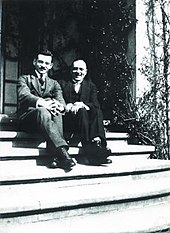Alexander Markowitsch Ostrowski

Alexander Ostrowski ( Ukrainian Олександр Маркович Островський , Russian Александр Маркович Островский ., Scientific transliteration Aleksandr Ostrovsky Markovič * 25. September 1893 in Kiev ; † 20th November 1986 in Montagnola in Lugano ) was a Russian - German - Swiss mathematician.
Life
Ostrowski's father was a businessman in Kiev. Alexander Ostrowski attended the business school , but took next to it even as a 15-year-old on the mathematical seminar of the University of Kiev under Dmitry Alexandrovich Grawe equal footing and also wrote his first publication. Since he only had a diploma from the commercial school, despite Grawe's advocacy, he was only able to study in Germany, where Kurt Hensel accepted him as a student at the University of Marburg in 1912. During his internment in World War I, at Hensel's advocacy, he was able to continue to use the library and concentrate entirely on mathematics.
In 1918 he resumed his studies at the University of Göttingen with David Hilbert and Edmund Landau and received his doctorate in 1920. He then worked with Erich Hecke at the University of Hamburg , where he completed his habilitation in 1922. From 1923 to 1927 he taught as a private lecturer in Göttingen. In 1925 and 1926 he was a Rockefeller Foundation fellow in England.
In 1927 Ostrowski was appointed to a full professorship at the University of Basel . In 1950 he acquired in Basel , the Swiss citizenship . After his retirement in 1958, he continued to teach as a visiting professor at various US universities and was also associated with the US National Bureau of Standards as a numeric specialist .
plant
Ostrowski made important contributions in many areas of mathematics, but especially in analysis. In 1920 he proved that Dirichlet series , the coefficients of which cannot be expressed by a finite basis, do not satisfy any algebraic differential equation, solving a problem posed by Hilbert (Hilbert treated the case of the Riemann zeta function ).
Two different, fundamental facts from valuation theory and the theory of amounts are often referred to as Ostrowski's theorem:
- The only possible amount functions on the rational numbers are (apart from equivalence) the trivial amount, the usual real absolute amount and the p-adic amounts for prime numbers p. Because of the relationship between amounts and reviews all reviews on are thus known, which in turn helps the ratings of certain field extensions of classifying.
- Every field that is complete with respect to an Archimedean amount is algebraically and topologically isomorphic to the field of real numbers or to the field of complex numbers. In other words: there is no real field expansion of the complex numbers to which the complex absolute value can be continued. A generalization of this theorem to complex Banach algebras is the Gelfand-Mazur theorem .
Ostrowski was in charge of numerical analysis and provided much accurate evidence of the convergence of different methods. In addition, he developed many stable processes that are still used today in numerics. He also worked a lot in numerics in linear algebra.
The Ostrowski Prize , named after him, has been awarded to outstanding achievements in mathematics since 1989.
Fonts
- Collected mathematical papers. 5 vol., Birkhäuser, Basel 1983–1984.
- Collection of exercises on calculus. Several volumes, Birkhäuser, Basel 1972 (first 1964).
- Lectures on differential and integral calculus, 3 vol., Birkhäuser, 2nd edition Basel 1963 (first 1945, 1951).
- Solution of equations and systems of equations. Academic Press 1960, New York 1965.
literature
- Acta Arithmetica 51, 1988, pp. 295-309, (with works catalog).
- Elements of Mathematics 43, 1988, pp. 33-38.
- Walter Gautschi : Ostrowski and the Ostrowski Prize , The Mathematical Intelligencer, 1998, no. 3, pp. 32-34.
- Walter Gautschi: Alexander M. Ostrowski (1893–1986): His Life and Work (English; PDF file; 660 kB)
- Erwin Neuenschwander: Alexander M. Ostrowski. In: Historical Lexicon of Switzerland . November 9, 2009 , accessed January 28, 2020 .
Web links
- Literature by and about Alexander Markowitsch Ostrowski in the catalog of the German National Library
- John J. O'Connor, Edmund F. Robertson : Alexander Markowitsch Ostrowski. In: MacTutor History of Mathematics archive .
- Website of the AM Ostrowski Foundation for an international prize in higher mathematics
- Ostrowski on Dirichlet series and algebraic differential equations , Mathematische Zeitschrift 1920
- Ostrowski on the development of numerical analysis , DMV annual report 1966
- Ostrowski investigations on the arithmetic theory of the body , part 1, Mathematische Zeitschrift 1935, evaluation theory , part 2,3
- Ostrowski's note on the stock of values of the Riemann zeta function on the edge of the critical strip , annual report DMV 1934, Mathematische Miszellen 18 , more of his "Mathematische Miszellen" are in the same place: Göttingen Digitization Center: GDZ
- Manuscripts by Peter Roquette, a. a. From the history of valuation theory zu Ostrowski
| personal data | |
|---|---|
| SURNAME | Ostrowski, Alexander Markowitsch |
| BRIEF DESCRIPTION | Russian-German-Swiss mathematician |
| DATE OF BIRTH | September 25, 1893 |
| PLACE OF BIRTH | Kiev |
| DATE OF DEATH | November 20, 1986 |
| Place of death | Montagnola |

